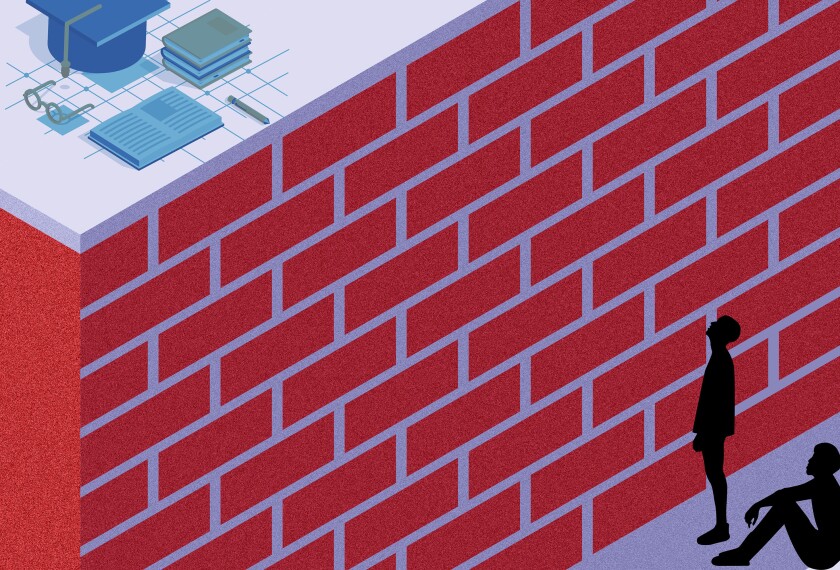Corrected: An earlier version of this article misidentified the lead author of the report. Eric Hengyu Hu was the lead author.
Data suggests socioeconomic factors play an important role in explaining the gaps in knowledge and skills that emerge between different racial groups as early as kindergarten—but that class doesn’t explain everything. That’s according to new research from the Thomas B. Fordham Institute, a conservative Washington think tank.
The report, released Aug. 21, builds on extended research from two decades ago that analyzed the achievement gap between Black and Hispanic students and their white peers, which suggested that a family’s socioeconomic status accounts for a large swath of the achievement gap. But it also isn’t the whole story.
“To us, there’s sort of two big takeaways,” said Paul Morgan, a professor at the University of Albany, one of the researchers for the report. “One: Class does seem to matter in terms of explaining racial and ethnic achievement gaps. And, two: Class, while important, doesn’t explain everything.”
Morgan and Eric Hengyu Hu, an education policy and postdoctoral researcher at the University of Albany, studied how 11 indicators of socioeconomic status within several measures, looking at background like household income, parents’ education, single parent status, etc. Their analysis found that socioeconomic factors explain between 34 and 64 percent of the Black-white achievement gap, depending on the subject (for example, math, science, or reading) and grade level, and between 51 and 77 percent of the Hispanic-white achievement gap.
The researchers used the Early Childhood Longitudinal Study, Kindergarten Class of 2011, a nationally representative data sample collected and released by the federal government that tracked the same students through 5th grade. The findings are made from correlation and regression analysis.
Different factors influence different students, Hu said. The research showed that household income best explains the Black-white achievement gap, while the mother’s level of education best explains the Hispanic-white gap. The researchers found that the role of each indicator didn’t change much between an older student data set, from 1998-99, and the 2011 data.
“Basically, we are saying that a mother’s education mattered 20 years ago, but also 10 years ago,” Hu said.
The study lists four proposed solutions—“none of which are novel but all of which might help,” the report notes—to address the gaps:
- Support programs to help parents earn high school diplomas or higher education credentials,
- Focus on early childhood education,
- Economic support and financial aid for low-income families, and
- Addressing racial and ethnic disparities through culturally responsive teaching and learning materials.
Hu added that the study intentionally did not include looking at the school factors. He recalled, as a graduate student, reading research papers about the school effect and feeling like there was too much burden placed on teachers and schools.
“At a certain point, we already see the [teacher] shortage, a high turnover rate in school. And if you interview the teachers, some teachers would say there’s a lot of pressure and a burden on them,” he said. “Definitely, school has to play a role, but what other kind of socially constructed indicators could we help?”
Still, socioeconomic status does not account for everything. The achievement gap between Black and white students continued to grow across elementary grades, and socioeconomic status explained less than half of the gap in math, science, and reading. For Hispanic students, socioeconomic status better explained achievement gaps over time.
The results, Morgan added, show that socioeconomic status is related to achievement and help explain it initially.
“But that doesn’t mean it’s ever too late to help,” he said.
Socioeconomic status isn’t the ‘silver bullet’ to achievement gaps
The adult education program in the Alexandria, Va., city public schools helps students over 18 get their GED, learn English, and complete workforce development training. Director of Adult Education Teri Barnett has seen parents come through her door: immigrants learning English and updating their skills, students who dropped out of K-12 and are coming back to pursue their high school diploma, mothers in daytime programs who then go home and care for their children.
Her program has federal and state funding and has done a lot, but it still has few resources, she said.
“Adult education is undervalued. It is underrecognized, because it’s not seen as K-12,” she said. “But it serves the community. Because these are the parents that serve the students that we serve, and serve the citizens we serve.”
Educated parents can better address issues their children may be having in their schools, she said, and give them a level of confidence to better support their children’s learning. But it ultimately doesn’t only fall to parents.
Keri Rodrigues, the founding president of the National Parents Union, said her constituencies—parents—are often indicted for not doing enough.
“The parents of today are the underserved kids of the previous generation,” she said. “While [socioeconomic status] is a really important factor, systemic inequities within the public education system—unequal access to quality teachers, advanced coursework, and extracurricular opportunities, all of those things need to be addressed.”
Black and Latino students are more likely to have teachers with one year or less of experience in the classroom, despite federal efforts to change that, according to previous EdWeek reporting. The United States spends billions more on white school districts than it does on predominantly nonwhite districts, according to previous EdWeek reporting.
One of the reasons All4Ed, a national advocacy organization working to expand education opportunities for students of color and students from low-income families, focuses on federal Title I funding and funding equity is to ensure that dollars are targeting the student communities that need that money the most, said Anne Hyslop, the director of policy development for the organization. Those conversations need to happen on the local level, too.
“When you have a budget, are you ensuring that you are targeting resources to your higher poverty schools? If you are recruiting teachers and your community that serves predominantly Latino students, do you have educators who are Latino in your schools?” she said. “There is no silver bullet here, but there are pieces that are completely within the control of the school that they can also focus on.”
Policy solutions outside of the education system—expanding the child tax credit, affordable childcare, expanding pre-K—are also vital, she said.
“This is sort of an all-hands-on-deck-crisis,” she said.




